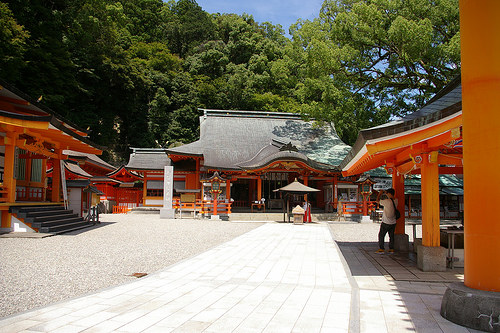The Nachi area of the Kii Peninsula in Japan has a long history as a place of worship. Let’s see how a waterfall, a holy tree and a Buddhist temple are part of this unique pilgrimage destination together with the Nachi Taisha, the Nachi Grand Shrine.

The Nachi waterfall is among the highest in Japan and are not only a tourist attraction but also an early place for nature worship for many centuries.
It is said that a Buddhist monk from India came here as early as the 4th century and built a hermitage. From this, both Buddhist temples and Shinto shrines developed. The sacred site became the destination for pilgrimages of the Emperors of Japan from the 10th to the 12th century providing a boost in popularity and importance of the Nachi area.
This is also the time that the pilgrimage paths across the Kii Peninsula – the Kumano Kodo – were established. They are still used today by pilgrims and are part of the UNESCO World Heritage.

Shinto Nachi Taisha Shrine
You will get a good impression of the pilgrimage trails if you take the traditional approach to the Nachi Taisha. The Daimon-zaka trail is a mountain path leading over stone stairs lined with century old cedar trees. It leads up for about one kilometer before ending at the Torii – the gateway to the temple complex.

The Nachi Taisha is one of the three Kumano Grand Shrines, which are among the most important Shinto shrines.
A unique feature between the buildings of the Nachi Taisha is an several centuries old camphor tree. It is considered to contain its own kami or deity. The tree is hollow and you can go inside to make offerings at a small altar.

Buddhist Seiganto-ji Temple
The area has more to offer however. Very close to the Shinto shrine complex lies a Buddhist temple. The Seiganto-ji temple is older than the Shinto shrines and can be traced back to the monk, who came here in the 4th century.
The Buddhist temple complex contains several buildings besides the picturesque pagoda. The main building is also the starting point for another – Buddhist – pilgrimage.
The combination of Shinto and Buddhist places of worship, called Jingu-ji, is very rare today. Many such complexes were destroyed in the 19th century in an effort to separate the two beliefs.
Finally, the Nachi waterfall itself should be visited. There is a small shrine at the base of the fall, which its 133 m of free fall is an impressive sight.

Shinto Fire Festival
Each July, an impressive fire festival is held at Nachi Taisha. Large portable shrines, each carried by one person are set on fire and carried up and down the steep stone stairs to purify them for the Shinto deities to visit the waterfall.
Have a look at this video, which also gives a nice overview of the Nachi Taisha:
© 2014 by Tadaima Japan
Further information on Nachi Taisha:
- Kumano Tourist Bureau
- Japan-Guide.com
- Wakayama World Heritage Center
- My ‘On-Historic-Routes’ article on the Kumano Kodo
Then sign up for our free email newsletter to get all our new posts right to your inbox.
